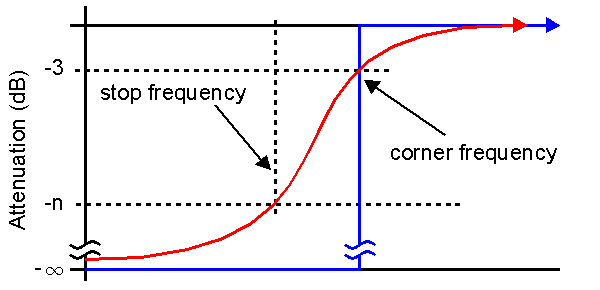

|
In the stylized graph above, the ideal high pass response shown in blue. This displays infinite attenuation at frequencies from zero to the corner frequency and zero attenuation at frequencies above that. The graph in red shows what the Butterworth filter can accomplish. In the filter that can be accomplished with lumped inductors and capacitors, the pass band allows up to three decibels of attenuation. |
At some lower frequency, specify a desired attenuation, n, in decibels. Make the slope of the graph between the 3 dB and the n dB points steeper by making the difference between the corner and stop frequencies smaller. Choose these frequencies wisely to design a filter that performs well in the current application. |
|
Determine a corner frequency which is a frequency that has an attenuation of 3 dB on its downward slope moving from higher to lower frequencies. For instance, there might be some interference on the broadcast band radio. A limit on the input below 500 kHz is needed. This is the corner frequency. At 400 kHz, the attenuation should be about 30 dB. That makes 400 kHz the stop frequency and the attenuation is 30. The input and output termination resistances are 50 Ohms. Type 500 kHz in the top box, labeled "Corner Frequency (Hz)" in a number of different fashions, using only the allowed characters 0-9, E (upper case is automatic), and . (a decimal point.) All of the following are legal: 500000, 5E5, 500E3. This is not allowed: 500 kHz. Following the same formatting, enter 400 kHz in the second box labeled "Stop Frequency (Hz)." And then in the third box enter 30, that's the box labeled "Attenuation (dB)" In the fifth box, labeled "In/Out Resistance (Ohms)," enter the termination resistances: 50. |
Click the "Computer Calculation" button in the green "Order" box. The computer will calculate the order and display it in the fourth box labeled "Order." Make an evaluation of the order number. It is possible that 16 (this example) was more than the number of capacitors and coils desired. Examine the criterion a second time. Perhaps less attenuation or a lower stop frequency could be used without suffering too much additional interference. For the moment, assume an order of 16 is acceptable. Click either the button labeled "Tee - Series" for a capacitor input filter, or "Pi - Shunt" for an inductor input filter. See the "Help - Geometry" for more information. After that button is clicked, the calculations are made. Depending on how the configuration is set up, the results may be shown immediately or use the "File - Retrieve" menu item to launch the text editor to see the results, or compute other filters. Later launch the text editor to see the files or open the Butterworth filter folder and double click the files to view the data after exiting the Butterworth Calculator. |
|
Consider fifth order high pass filter with a corner frequency at 9500 kHz and 50 Ohms input and output termination resistances. Past experience guides this decision. Type 9500 kHz in the top box, labeled "Corner Frequency (Hz)" in a number of different fashions, using only the allowed characters 0-9, E (upper case is automatic), and . (a decimal point.) All of the following are legal: 95000000, 9.5E6, 9500E3. "9500 kHz" is not legal. Type a "5" in the fourth box in the panel labeled "Order." Type 50 in fifth box labeled "In/Out Resistance (Ohms)." At this time, the Butterworth calculator can only handle equal input and output termination resistances. In the green "Order" panel, click the "Manual Entry" button. |
The corner frequency and the order are now locked in. Click either the button labeled "Tee - Series" for a capacitor input filter, or "Pi - Shunt" for a inductive input filter. See the "Help - Geometry" for more information. See Example One for how to view the computed data or retrieve the saved data files. |
|
If the filter has a corner frequency in the range of 50 kHz to 75 kHz, consider an active filter. The upper end of the pass band will be limited by the filter geometry and the gain-bandwidth product of the amplifiers. The low cost of top quality operational amplifiers and the associated resistors and capacitors make the active filter an attractive option. |
If the filter has a corner frequency above about 500 MHz, consider other techniques entirely. The small electrical size of the lumped elements make stray capacitances and inductances an important part of the physical layout possibly detuning the entire circuit. The Butterworth Calculator is limited to frequencies less than 1E10 Hz. |



